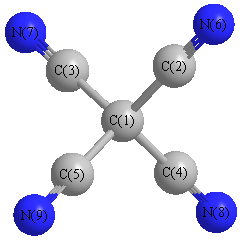Vibrational Frequencies calculated at MP2/6-31G(2df,p)
| Mode Number |
Symmetry |
Frequency
(cm-1) |
Scaled Frequency
(cm-1) |
IR Intensities
(km mol-1) |
Raman Act
(Å4/u) |
Dep P |
Dep U |
|---|
| 1 |
A1 |
2188 |
2067 |
0.00 |
|
|
|
| 2 |
A1 |
590 |
557 |
0.00 |
|
|
|
| 3 |
E |
560 |
529 |
0.00 |
|
|
|
| 3 |
E |
560 |
529 |
0.00 |
|
|
|
| 4 |
E |
110 |
104 |
0.00 |
|
|
|
| 4 |
E |
110 |
104 |
0.00 |
|
|
|
| 5 |
T1 |
335 |
316 |
0.00 |
|
|
|
| 5 |
T1 |
335 |
316 |
0.00 |
|
|
|
| 5 |
T1 |
335 |
316 |
0.00 |
|
|
|
| 6 |
T2 |
2193 |
2071 |
27.76 |
|
|
|
| 6 |
T2 |
2193 |
2071 |
27.76 |
|
|
|
| 6 |
T2 |
2193 |
2071 |
27.76 |
|
|
|
| 7 |
T2 |
1086 |
1026 |
24.52 |
|
|
|
| 7 |
T2 |
1086 |
1026 |
24.52 |
|
|
|
| 7 |
T2 |
1086 |
1026 |
24.52 |
|
|
|
| 8 |
T2 |
547 |
516 |
0.01 |
|
|
|
| 8 |
T2 |
547 |
516 |
0.01 |
|
|
|
| 8 |
T2 |
547 |
516 |
0.01 |
|
|
|
| 9 |
T2 |
143 |
135 |
13.60 |
|
|
|
| 9 |
T2 |
143 |
135 |
13.60 |
|
|
|
| 9 |
T2 |
143 |
135 |
13.60 |
|
|
|
Unscaled Zero Point Vibrational Energy (zpe) 8513.5 cm
-1
Scaled (by 0.9445) Zero Point Vibrational Energy (zpe) 8041.0 cm
-1
See section
III.C.1 List or set vibrational scaling factors
to change the scale factors used here.
See section
III.C.2
Calculate a vibrational scaling factor for a given set of molecules
to determine the least squares best scaling factor.
